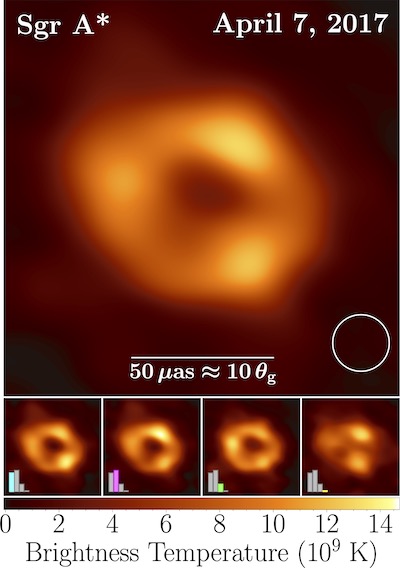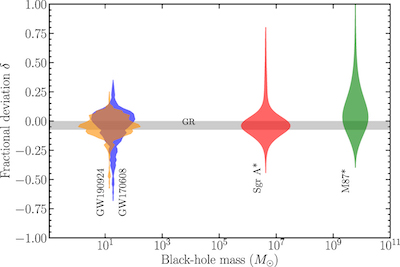
SgrA* revealed
by Ilse van Bemmel (JIVE, the Netherlands) and Huib van Langevelde (JIVE, the Netherlands)
The Event Horizon Telescope Collaboration (EHTC) made global front page news with the first images of the M87 supermassive black hole in 2019. To image our Galactic black hole, Sagittarius A* (SgrA*), turned out to be a much bigger challenge. At last, on Thursday 12 May 2022 the EHTC presented the first image of SgrA* to peers and the public. This happened at different venues around the globe, with ESO headquarters in Garching, Germany, covering the news for Europe.

obtained
across multiple methods. The insets represent
different imaging solutions and their associated frequency.
The data for this image were obtained in the same observing run in 2017, but included a set of new and unique challenges to overcome. The much smaller intrinsic size of SgrA* causes it to vary on much shorter times than the typical length of a VLBI observing track. It was compared to taking a picture of a dog chasing its tail in a dark room. Consequently, it took several years for the EHTC to develop robust techniques for imaging and image validation. Eventually, an entire family of images was produced which is compatible with the data, and 97% of these images are consistent with a ring-like structure with a diameter of ~51 micro-arcseconds. The image shown to the press and public is a weighted average across this family (see Figure 1).
Although the SgrA* image is second to the M87*, imaging our Galaxy’s black hole probably represents a more fundamental result, because mass and distance are so much more accurately determined as stars in orbit around it have been measured with great accuracy. The general public showed a keen interest in the result. The results were covered by many media and EHTC astronomers were in the news around the world.
Vetting and validating: the papers
A scientific result of this calibre requires extensive analysis of all the aspects at hand. From the calibration and imaging of the observations, to extensive GRMHD simulations, to alternative models of gravity, every aspect is presented in detail in six “collaboration” papers by the EHTC. Four additional studies that were not directly connected to the image resulted in “official” papers. These ten papers were made public at the time of the press release. These papers are highly synergetic, by design, together they tell a complete story. Simulations generated to study the physics of accretion flows are essential to test imaging and analysis methods. At the same time, the observations from EHT and other instruments are extremely constraining and set hard limits on the GRMHD simulations.
For the quick summary, paper I describes all the high-level results from the six collaboration papers and the main result: the SgrA* observations are consistent with a ring as expected from lensing magnetised plasma. The diameter of 51 micro-arcseconds matches well with the known size and distance of the Galactic black hole. But the devil is in the details.
An essential and unique part of the SgrA* work are the multi-wavelength observations. The complexity of requesting, planning, and processing data from several additional instruments is not apparent from the papers. However, the constraints derived from these observations are crucial in setting constraints on the physical parameters for GRMHD models (paper II, paper V).
Some basic analysis can already be done before imaging. The visibility amplitudes as a function of uv-distance indicate a ring like structure, and modelling this can constrain the diameter and inclination of the ring. So even without the imaging, which can have its own caveats, this is the first evidence for a ring, but the ring model is not a unique fit (paper II, paper IV).
Of course, having an image is what everyone is expecting, and this was a big challenge. The entire Galaxy blocks our view of SgrA*, causing significant interstellar scattering. In addition, due to its smaller size SgrA* varies both in intensity (amplitude) and in structure (phase) on timescales of minutes to hours. It therefore violates the assumption of aperture synthesis that a source does not change during the observation. To obtain a robust image, the different imaging teams first ran their pipelines on a large library of artificial data, based on seven distinct source models and GRMHD simulations that would fit the visibility data. The parameter combinations that provided the best results were then used to image the actual data. This resulted in many images from each pipeline, with the large majority consistent with a ring-like structure. The diameter of the ring is very stable, but the azimuthal structures are less constrained, resulting in three different families of ring-like images. A fourth family consists of non-ring images (paper III). The final image is a weighted average of all these families, with the relative weights indicated by the bars in the image (see Figure 1).
Measuring the ring properties —from images or visibilities directly— also requires a robust approach, and the methods are again tested first with the simulated data before being applied to the actual observations. The data are consistent with the Kerr black hole metric and known mass and distance for SgrA* (paper IV). Alternative gravity and black hole models are considered, but show no indication that general relativity falls short. SgrA* and M87* look remarkably similar. Spanning over three orders of magnitude in scale, both images are dominated purely by gravity (paper VI, Figure 2).

fractional deviation from the GR prediction, for Sgr A*
(red), and two LIGO/Virgo events (paper VI).
Such sharp images of black holes provide a wealth of constraints for our understanding of accretion physics. A large library of GRMHD simulations was made and compared to a set of 12 constraints derived from the observations. The simulations are seriously challenged. The most constraining parameter is the variability, which is very poorly matched by any of the simulations. Nevertheless, the most preferred model is a magnetically arrested disk, with an accretion rate at starvation level. The rotation axis of the gas is likely close to our line of sight, so it would notably be offset from Galactic rotation.
In summary, the image of SgrA* was a challenge to make, but the ring feature is quite robust at a diameter of 51 micro-arcseconds. Strong constraints can be derived from the data to challenge our understanding of accretion physics. And finally, Einstein is still not wrong.
Impact and forward look
Explaining such intricacies to the general public with a picture that looks just like “another orange doughnut” was expected to be a major challenge. Having learned from the M87 experience, a dedicated outreach strategy was developed, involving discussions on social media platforms, and a timeline to provide small chunks of information over an extended period to keep the interest. Despite some last minute adjustments, this worked really well. The SgrA* story reached a considerable fraction of the exposure that the M87 result had, and the public was quite receptive to our explanations as to why this image of “our” black hole is even more fundamental.
The EHTC marches on and has a pile of data that still needs to be published. Important is to show that M87 looks similar a year later and with a higher fidelity array. The polarisation of SgrA* can maybe better constrain the models. And of course, we want to explore the time domain sampling of the black hole images. This will improve when we have more telescopes, more bandwidth and additional higher frequency data.